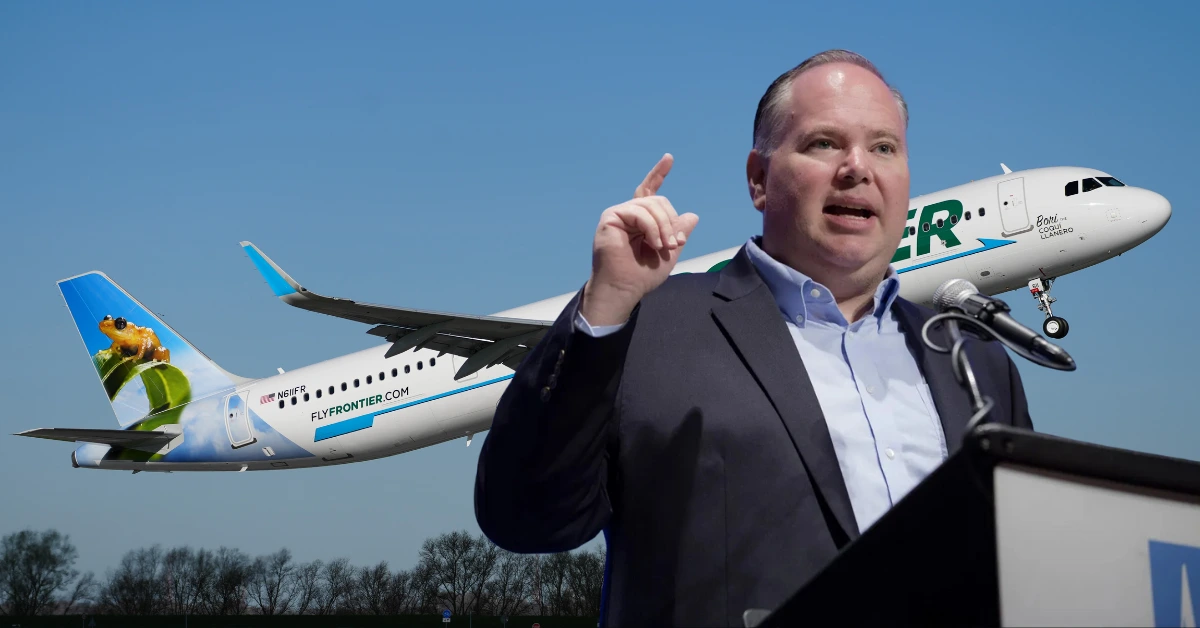In 2025’s crowded airline market, profits are elusive, and one of America’s largest low-cost carriers is making it clear that the way we fly in the United States is about to shift.
Frontier Airlines, ranked the eighth-largest U.S. airline last year by Air Service One, has released its latest financial results. While the numbers point toward long-term improvement, the company’s CEO has also issued a warning that could affect millions of travelers.
Frontier’s second-quarter earnings report showed $929 million in revenue, a strong number on paper. But the airline still logged a net loss of $70 million. CEO Barry L. Biffle, however, insisted the results fell within the company’s expectations and that the business is on a steady path toward profitability, a goal he believes Frontier will achieve in 2026.
“We’re in line with our guidance, and we believe we’re well-positioned for the coming year,” Biffle said during the earnings call. While that statement sounded confident, it wasn’t the main takeaway from his remarks.
The more striking part of his message was a blunt industry-wide forecast that many passengers won’t want to hear: U.S. airlines are preparing to cut flights, and this could mean fewer options for travelers in the very near future.
An 11-Word Warning for the Airline Industry
In one of the most pointed comments of the earnings call, Biffle summed up the challenge facing carriers:
“There’s going to continue to be reductions in capacity in this industry.”
That phrase, just 11 words long, carries major implications. In airline terms, “capacity” refers to the number of flights and available seats in the market. Reductions in capacity mean airlines will operate fewer flights, potentially cut entire routes, and offer fewer departure time options.
The core problem, Biffle explained, is simple economics: too many planes are flying compared to the number of passengers willing to pay enough to make those flights profitable.
“I’m talking about domestic fares in the domestic marketplace,” Biffle said. “We believe that the entire industry is not making money. If you take out your code share, take out your international flow, the domestic [segment] is not making money. And that’s because there is too much supply relative to demand.”
This is a bigger issue than just Frontier’s balance sheet. It affects the entire domestic airline industry, and by extension, anyone booking a U.S. flight.
United Airlines Backs the Warning
Biffle’s comments were soon echoed by another major airline leader: United Airlines CEO Scott Kirby. In his own company’s earnings call, Kirby painted a similar picture of the U.S. aviation market.
“If I dig deeper into it and I look at every airline that’s not named United or Delta,” Kirby said, “I can find at every single one of them a double-digit percentage of their route network that loses money. And the only way for them to get margins that are anywhere close to their WAC [weighted average cost] is to stop flying places that lose money. And that is going to ultimately happen.”
In other words, if a flight route doesn’t earn its keep, airlines will stop operating it. And that’s not an “if,” it’s a “when.”
Why Airlines Are Losing Money on Domestic Routes
Both CEOs point to the same underlying issue, supply and demand. When the supply of available seats in the domestic market outweighs the number of paying customers, ticket prices drop. While that’s great for bargain hunters, it’s unsustainable for airlines, especially with rising fuel prices, labor costs, and maintenance expenses.
During the pandemic recovery period, many airlines increased capacity quickly, anticipating a strong rebound in demand for domestic leisure travel. While international travel has boomed, the U.S. domestic market hasn’t been as robust as expected. Business travel, which traditionally brings in higher fares, still hasn’t returned to pre-2020 levels, further squeezing revenue.
Low-cost carriers like Frontier and Spirit built their models around high aircraft utilization and low fares, but even these budget-friendly operations can’t survive if too many flights operate with slim or negative margins.
What This Means for Flyers in 2026 and Beyond
If the forecasts from Biffle and Kirby prove correct, U.S. travelers could see noticeable changes in the next 12–18 months. These changes could include:
- Fewer Flight Options – Certain times of day, especially early mornings and late evenings, may see fewer departures.
- Route Cancellations – Smaller cities or less-popular destinations could lose direct flights altogether, forcing passengers to make connections.
- Seasonal Adjustments – Routes that operate year-round today may shift to seasonal service, operating only during peak demand months.
- Higher Prices on Remaining Flights – When capacity is reduced, competition for seats on remaining flights can drive fares up.
Travelers who like to fly on off-peak days (such as midweek) or during shoulder seasons may feel the impact most, as airlines are likely to cut back service in those periods first.
The Cuts Have Already Started
While the CEOs’ comments point toward the future, signs of these reductions are already visible. Spirit Airlines, another major budget carrier, has begun cutting flights during low-demand periods. Other carriers have quietly adjusted schedules, reducing service in less profitable markets.
Airlines often test these reductions by trimming certain flights before making permanent cuts. If passenger numbers don’t justify restoring those flights, they disappear from the schedule entirely.
Industry Shakeups Could Reshape U.S. Air Travel
This isn’t just about a temporary adjustment. If the entire domestic airline market is oversaturated, as Biffle and Kirby claim, the next few years could bring a fundamental shift in how airlines operate.
Smaller regional airports may lose service from certain carriers, pushing travelers toward larger hubs. Airlines may focus more heavily on international markets, where demand and profitability appear stronger. And budget airlines may have to rethink their ultra-low-cost model if domestic routes can’t consistently turn a profit.
For travelers, this could mean planning farther ahead, being flexible with departure and arrival times, and potentially paying more for flights that were once inexpensive.
Why This Matters Now
Biffle’s warning isn’t just an industry-side issue, it’s a consumer issue. For decades, competition among U.S. airlines has given travelers more choice, lower fares, and greater flexibility. If capacity shrinks significantly, that competitive pressure could ease, and prices could creep upward.
For frequent flyers, fewer routes mean fewer opportunities to earn and redeem loyalty points on preferred airlines. For occasional travelers, it could mean rethinking vacation plans if affordable, convenient flights disappear.
This also affects tourism-dependent communities. Many smaller U.S. cities rely on steady air service to support local economies. Losing routes can have ripple effects far beyond the airport.
What You Can Do as a Traveler
While passengers can’t control airline capacity decisions, they can adapt. Here are a few strategies to prepare for possible changes:
- Book Early – With fewer flights available, waiting for last-minute deals may be riskier.
- Stay Flexible – Being open to alternative airports or travel dates can help you find better fares.
- Monitor Airline Announcements – Schedule changes can happen months in advance. Staying informed can help you rebook without last-minute stress.
- Consider Loyalty Programs – Being a frequent flyer with an airline may give you priority when flights are rebooked or capacity is tight.



